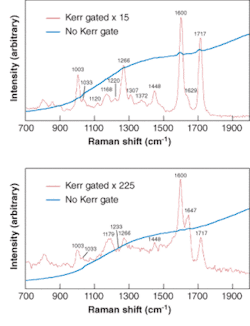
The development of a technique for analyzing street drugs that overcomes accuracy problems associated with other methods could pave the way toward future portable detection systems used in crime-scene investigations.
Scientists from the University of Strathclyde (Glasgow, Scotland) and the Rutherford Appleton Laboratory (Didcot, England) have developed a laser-based technique to detect and analyze street drugs; the approach uses Raman spectroscopy to generate a clear fingerprint for the substance even in the presence of large amounts of contaminant.
The technique was developed by members of the Central Laser Facility, which operates from the Council for the Central Laboratory of the Research Councils (one of the U.K.’s government-funded research councils), Rutherford Appleton Laboratory, and the Department of Pure and Applied Chemistry at the University of Strathclyde.
Previously, the analysis of street samples of drugs by Raman spectroscopy has been hindered by the fluorescent properties of many of the common cutting agents, which include brick dust, sugars, caffeine, chalk, flour, and talcum powder. This problem has reduced the effectiveness of the technique as a practical way of analyzing drugs. Near-IR Fourier-transform Raman spectroscopy has been used for the analysis of pure samples of diamorphine (heroin), morphine, and codeine, but complex samples, such as street samples, can give significant fluorescence even with near-IR excitation. The use of UV excitation has been shown to reduce fluorescence in samples of heroin and cocaine, but the high laser powers used can burn the sample. Surface-enhanced Raman scattering (SERS) has been used for the analysis of amphetamine, heroin, and cocaine, but this approach produces complex spectra that are difficult to interpret, and also involves the destruction of some of the sample by adding silver colloid to obtain SERS.
Fast optical gate
The new system overcomes these problems by using Kerr-gated fluorescence-rejection Raman spectroscopy. The Kerr gate is a fast optical gate that opens briefly to let through the Raman-scattered light, and then closes to reject the bulk of the fluorescence (see figure). The team claims that this technique, apart from being nondestructive and noninvasive, produces spectra that are clearer and easier to interpret than those produced by other methods.
The Ti:sapphire laser in the system has a regenerative amplifier followed by a two-pass linear amplifier. The laser is operated at 800 nm, with 1-ps pulses and a pulse energy of 2 to 3 mJ at a 1 kHz repetition rate. The laser output is split in two; a 500-µJ pulse portion becomes the gating pulse to drive the Kerr gate, while the remainder of the pulse is frequency-doubled to pump two laboratory-built optical parametric amplifiers that generate the tunable pulses used for Raman excitation. The Kerr gate consists of two crossed polarizers and a Kerr medium. In the closed state, collimated light collected from the sample is blocked by the crossed polarizers. The gating pulse creates a transient anisotropy within the Kerr medium by the optical Kerr effect. The intensity of the gating pulse is adjusted to create an effective half-wave plate, rotating the polarization of the light from the sample by 90°, allowing it to be fully transmitted through the cross polarizer for the duration of the gating pulse.
Dick Lacey at the U.K. government’s Home Office Scientific Development Branch notes that although the results from this early research are extremely encouraging, a system for use at the scene of crime is not available yet. “The equipment on which we have been testing the new technique needs a laboratory-based spectrometer which requires high-power lasers and is very expensive,” he says. “However, as the technology advances, we expect that smaller units that are simple to operate will become available.”
“The Kerr-gated Raman technique has a wide range of other uses,” says Pavel Matousek, a researcher at the Central Laser Facility. “For example, we are developing a new method for noninvasive probing of biological tissue for diagnosing disease and for assessing the quality of pharmaceutical products.”